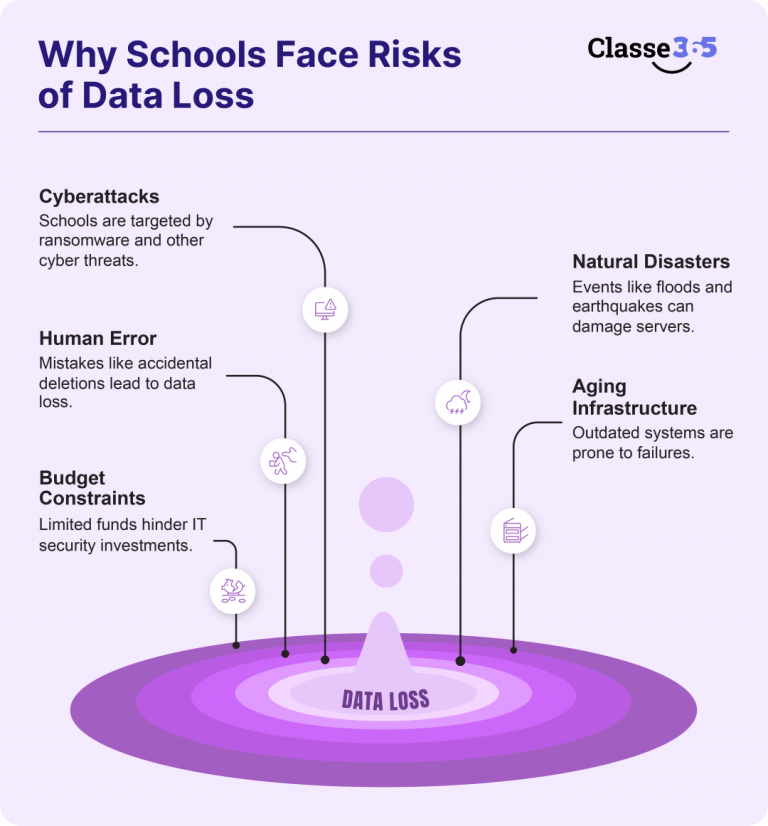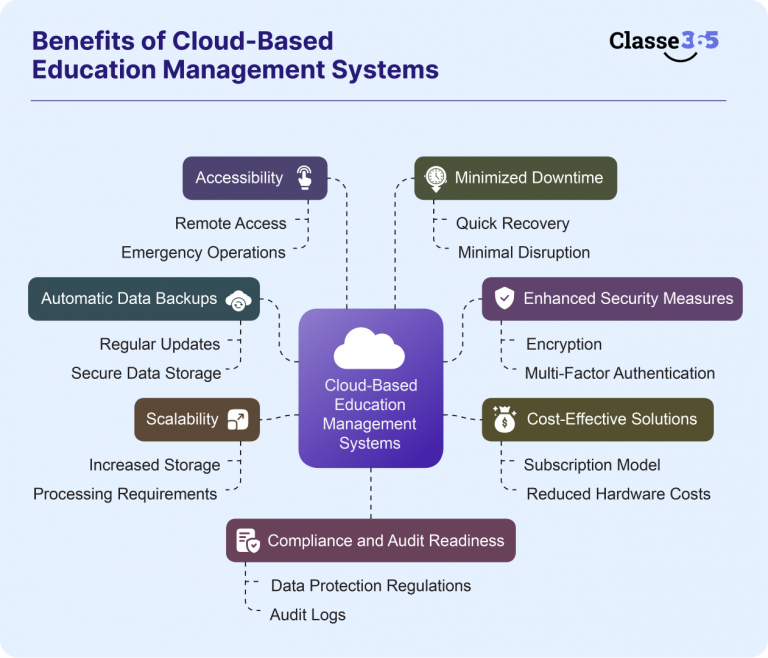Data lies in the heart of all educational institutions in this digital age. It enhances the learning experience, streamlines operations, and makes informed decisions. Data forms the foundation of an institution handling student records, lesson plans, and administrative workflows.
No matter how smooth and secure the data storage system looks. Any unforeseen disasters such as cyberattacks and operational downtime can disrupt this seamless flow of data harnessing long-term damage to institutional credibility.
This is where cloud-based school management systems come into the scene, offering foolproof disaster recovery solutions and data backup.
Understanding Disaster Recovery and Data Backup
Data backup and disaster recovery work simultaneously to ensure your system’s flawless operation even after damage to the system.
Data backup means creating and storing copies of critical information to prevent loss of data.
Data discovery focuses on restoring the data and resuming normal operations after a disruptive event.
Both of the processes are essential for schools. A sudden system crash or data breach could compromise sensitive information such as student grades, medical records, and financial details.
For instance, PowerSchool experienced a recent data breach on January 7th, 2025 resulting in students’, teachers’, and parents’ confidential data piracy. This data breach has compromised sensitive information such as student grades, medical records, and financial details.
Here comes the requirement of a cloud-based school management system that helps institutions protect their data and reputation.
Why Schools Are Vulnerable to Data Loss

Schools are especially vulnerable to data loss because it concerns children’s data along with other stakeholders. Anyone willing to attack a particular community, children are the softest target. So, data breaches in schools feel most dangerous. Here are some of the key vulnerabilities:
Cyberattacks
Schools are prime targets for ransomware attacks. Hackers encrypt critical data and demand a ransom for its release.
Natural Disasters
Floods, fires, and earthquakes can damage on-premise servers, leading to irreversible data loss.
Human Error
Accidental deletion of files or improper handling of systems can result in data breaches or loss.
Aging Infrastructure
Many schools rely on outdated hardware and software that are prone to failures.
Budget Constraints
Limited budgets often lead schools to underinvest in IT security and backup systems.
Considering these risk factors, it’s clear that schools need a proactive approach to safeguard their data. This is where cloud-based education management systems come in.
What Are Cloud-Based Education Management Systems?
Cloud-based education management systems store data and run applications on remote servers that anyone can access via the Internet. Unlike traditional on-premise solutions, cloud-based systems offer flexibility, scalability, and enhanced security. These systems serve as an all-in-one platform for managing student information, attendance, grade communication, and administrative tasks.
Benefits of Cloud-Based Education Management Systems for Disaster Recovery and Data Backup
Automatic Data Backups
There is no risk of losing data while working with a cloud-based system as it automatically updates data regularly. This ensures that even if a disaster strikes, schools can recover the most recent version of their data without manual intervention. Unlike traditional methods where backups may be stored on physical drives susceptible to damage, cloud backups are stored in secure, redundant data centers.
Enhanced Security Measures
Leading disaster recovery cloud providers offer robust security protocols, including encryption, multi-factor authentication, and intrusion detection systems. These features help protect sensitive school data from cyber threats.
Cost-Effective Solutions
Implementing an on-premise disaster recovery plan can be expensive, requiring investment in hardware, software, and IT personnel. Cloud-based systems for disaster recovery operate on a subscription model, making them more affordable for budget-conscious schools.
Scalability
As schools grow and their data needs expand, cloud-based systems can easily scale to accommodate increased storage and processing requirements. This eliminates the need for costly hardware upgrades.
Accessibility
Cloud-based systems allow authorized personnel to access data from anywhere with an internet connection. This is particularly useful during emergencies, enabling schools to resume operations remotely if physical premises are inaccessible.
Minimized Downtime
With quick data recovery capabilities, cloud-based systems help minimize downtime, ensuring that teaching and administrative functions can resume with minimal disruption.
Compliance and Audit Readiness
Many cloud providers adhere to strict data protection regulations, ensuring that schools remain compliant with laws like the General Data Protection Regulation (GDPR) or the Family Educational Rights and Privacy Act (FERPA). These systems also maintain detailed audit logs, simplifying compliance reporting.

Overcoming Barriers to Cloud Adoption
Despite the clear benefits, some schools may hesitate to adopt cloud-based education management systems due to concerns about cost, data security, or complexity. Here’s how these challenges can be addressed:
Cost Concerns: While the initial transition to a cloud-based system involves costs, the long-term savings in maintenance, hardware upgrades, and disaster recovery make it a cost-effective choice.
Data Security: Partnering with reputable cloud providers ensures that data is protected with the latest security protocols. Schools should also invest in training staff on cybersecurity best practices.
Complexity: Many cloud-based systems are designed to be user-friendly, with intuitive interfaces and dedicated support teams to assist schools during the transition phase.
How to Choose the Right Cloud-Based Management System
When selecting a cloud-based management system for disaster recovery and data backup, schools should consider the following factors:
Data Storage and Backup Policies: Ensure the provider offers automated, redundant backups with easy recovery options.
Security Features: Look for systems with advanced security measures, including encryption, firewalls, and intrusion detection.
Scalability: Choose a system that can grow with the school’s needs.
Ease of Use: The platform should be intuitive and require minimal staff training.
Customer Support: Reliable customer support is essential for addressing issues quickly during emergencies.
Compliance: Verify that the system complies with relevant data protection regulations.
The Future of Disaster Recovery in Education
As technology evolves, the role of cloud-based education management systems in disaster recovery will only grow. Emerging technologies like artificial intelligence (AI) and machine learning are being integrated into these systems to predict potential risks and automate responses. For instance, AI-powered analytics can identify unusual activity that may indicate a cyberattack, enabling schools to take preventive action.
Additionally, as 5G networks become more widespread, the accessibility and speed of cloud-based systems will improve, further enhancing their effectiveness in disaster recovery scenarios.
In an era where data is central to educational success, schools cannot afford to overlook the importance of disaster recovery and data backup. Cloud-based education management systems provide a reliable, cost-effective, and secure solution to safeguard critical information and ensure continuity in the face of adversity. By embracing these technologies, schools can not only protect their data but also enhance their operational efficiency, ultimately providing a better learning environment for students.
The future of education lies in the cloud, and the time to invest in this transformative technology is now. With the right cloud-based management system, schools can navigate the uncertainties of the digital age with confidence, knowing that their data—and their mission—are secure.
